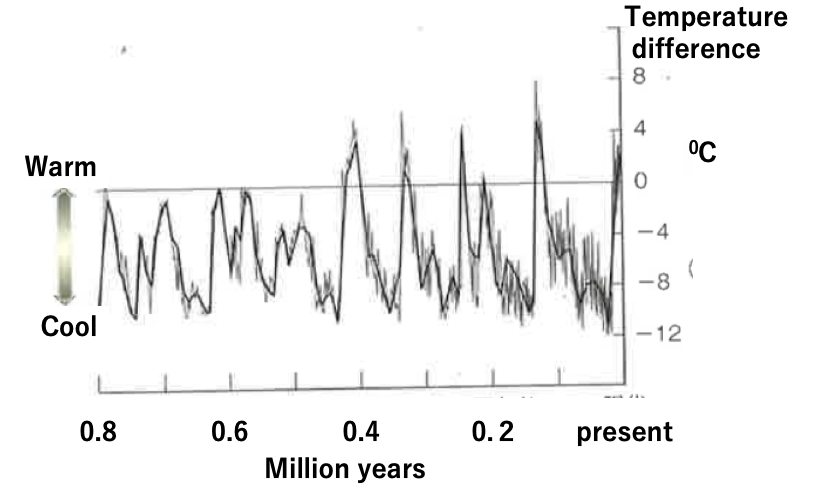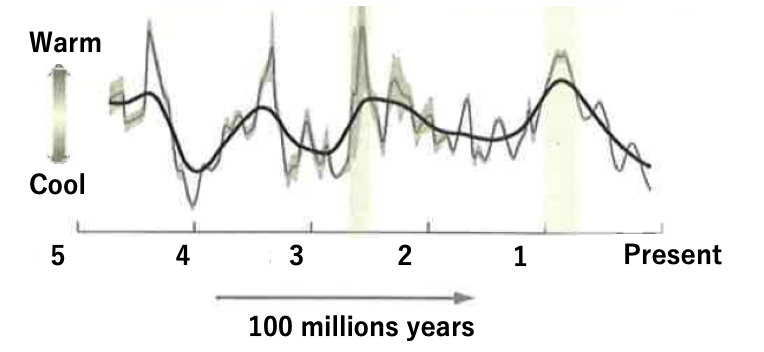
How Paleoclimatology Affects Daily Life
Here in Awaji and throughout Japan, people were shocked by record-breaking heat this summer. According to Kobe weather station, the average temperature in September this year was 28.5 degrees, 3 degrees higher than that of the last century, and the same as in August. In other words, summer did not end until the end of September. This unusual weather pushed up prices of agricultural products, affecting daily life. Several times through the course of history, Japan has suffered indescribable damage from draught and / or cold weather roughly once every 100 years. Such disasters contributed to tragic outcomes, from the slave trade to poverty among farming families. With this in mind, knowing whether current unusual weather patterns will continue or not is of great importance. Studies based on paleoclimatology may shed some light on what lies ahead. Here is a an overview of several books that show the recent achievements in Paleoclimatology.
An analysis of glaciers in the Alps and Antarctic has revealed evidence of an Ice Age millions of years ago. Every year during that period, more and more snow piled up to create these massive blocks of ice. By pinpointing a certain layer, we can roughly estimate when it was formed. By analyzing the content of 18O in H2O, an isotope of an oxygen atom (16O) in a certain layer, researchers of Paleoclimatology can ascertain the temperature even a million years ago. Those results show little evidence of glaciers in the Antarctic during the age of dinosaurs. A warm climate may have been needed to support the bounty of plant life required to support colossal lifeforms such as dinosaurs.
This study establishes that earth temperatures fluctuate in cycles of roughly 100 million years. One temperature peak occurred around 250 million years ago in the age of dinosaurs. The temperature subsequently fell then rose back to peak again around 100 million years ago. Since that time, the planet has been in a cooling phase.


Fig. Cyclic temperatur change (upper fig. among millions years, lower fig. among 100 millions years)
Further study shows that even during phases of falling overall temperatures, small cycles of volatility were observed. A climate warmer then now prevailed about 5,000 years ago, and several large villages developed in the Aomori and Akita areas, some of which still remain, including San-nai Maruyama. As time passed, the cooling climate made conditions difficult for the large chestnut forest that fed and supported the village, making life untenable. A thousand years later, Heian period aristocrats frolicked in the hills of a warm climate once again. From that time, overall temperatures have slid.
Now, 2 factors are believed to be causing cyclical long term temperature changes similar to those observed 100 million and/or 10,000 years ago. One set of factors are geological changes of the earth, including volcano eruptions, as well as heat produced by friction between moving tectonic plates.
Another set of factors are related to a theory raised by Dr. Milankovitch, a Serbian earth physicist to explain the phenomena. Dr. Milankovitch has shown that mutual orientation between the sun and earth affects the total amount of solar heat energy that reaches our planet. According to this theory and previous observations, climatology researchers have predicted that the earth would eventually cool.
However, temperatures since the Industrial Revolution 100 years ago have been going up. This increase is believed to be due to increasing carbon dioxide and subsequent “Greenhouse” effects. Oxygen produced by reactions between photosynthetic bacteria and carbon dioxide also have an effect. An increasing world population requires more food, and therefore greater agricultural output. According to most researchers, this supply is possible only under stable climate conditions. How can humanity survive under volatile climate patterns like those experienced this year?
Ref. 1. Human life and climate change during the last one millions years (in Japanese), T. Nakagawa Kodansha Blue books (2017), 2. Climate change during the last 46 millions years, Y. Yokoyama (in Japanese) Kodansha Blue books (2018), 3. Climate change of earth history (in Japanese) M. Mizuno NHK books (2016).
